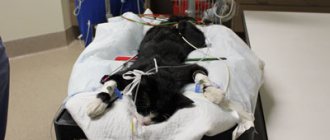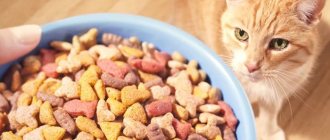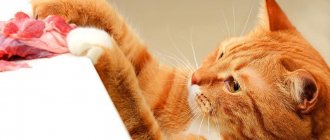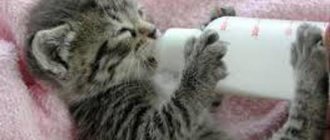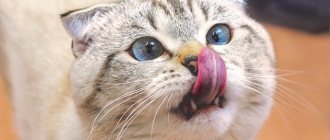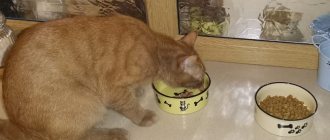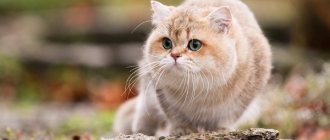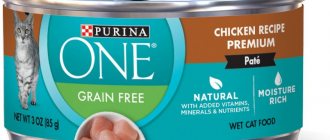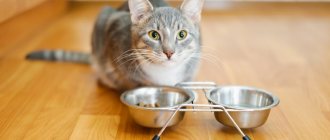It just so happened that when a small light lump appeared in my house, I had exactly two days left to admire the pink freshness of my heels. And then began 8 months of struggle against shitty paws and other unpleasant consequences of diarrhea in this furry animal.
In general, it is cultural, of course, to write - diarrhea, but those who have encountered its variations, alas, do not smell violets, but experience the whole gamut of completely unpleasant emotions and feelings. So I will call this matter by its popular name. Our cat didn’t have diarrhea, but real protracted diarrhea, in several different variations, may the aesthetes forgive me.
From the first minute in the house, the cat looked downright strange. Huge ears, wet nose and constantly hungry eyes. Hryundel attacked the food like a starving man from the Volga region, although he himself seemed to be one of the “decent and cultured” purebred Maine Coons, and not some Vasek from the fence. You can’t keep anger inside yourself, so the cat’s diarrhea also developed rapidly, in proportion to the children’s grub he had eaten.
For the first two days we listened to the breeder’s tales about how the cat’s reaction to the vaccine was a reaction, but then we became desperately short of fresh air in the one-room apartment and we decided to finally discover for ourselves the cause of the cat’s open bowels. And we began to study the question of how to stop our cat’s diarrhea.
Symptoms of diarrhea
Diarrhea is characterized by general symptoms:
- loose stools;
- frequent bowel movements;
- flatulence;
- blood, mucus and feces.
If diarrhea signals an illness, secondary symptoms may appear:
- decreased or increased appetite;
- weight loss;
- vomit;
- temperature increase;
- decreased pet activity;
- drowsiness.
Secondary symptoms should be addressed as early as possible. To diagnose the disease in time and begin treatment.
A cat has bloody diarrhea, with mucus, and vomiting: what to do, treat it at home or see a doctor?
Treating a cat for diarrhea
As you probably already understood, quite serious pathologies can provoke diarrhea in a cat. In view of this, it will be better if you immediately begin to take measures when loose stools appear. As for bloody diarrhea with mucus and vomiting, its occurrence must be treated as responsibly as possible. As practice shows, the cause of its appearance can be either obstruction of the entire intestine, or severe inflammation of only the colon.
If blood has already appeared in the stool, this indicates that the mucous membranes of the gastrointestinal tract are so inflamed that they have begun to become covered with wounds. This means that without proper and, most importantly, immediate therapy, the animal will inevitably die. I would like to say right away that such pathologies must be treated under the strict supervision of a specialist. Therefore, it will be better if you take your pet to the veterinarian as soon as possible. This pathology is treated in several stages.
At first, the animal is given drugs that stop the bleeding. This could be, for example, Dicynon . It is given to the animal 2 times per knock, 0.5 - 1 ml at a time. In addition, the cat is given ordinary clean water along with the drug. As soon as the bleeding stops, you can move on to blocking inflammation and restoring the microflora. For these purposes, sick animals are prescribed Metronidazole (20 mg per kilogram of body).
Duration
Loose stools in cats can last for varying durations. Sometimes the sudden onset of diarrhea also ends suddenly. During this time, the animal did not change its behavior or appetite. A one-time bowel movement is not a reason to be upset. The manifestation of diarrhea and its continuation for a certain time divided it into certain groups.
- acute – the duration of diarrhea is more than two days;
- chronic – more than 7 days;
- intermittent – up to 30 days.
The first group does not pose a threat to health and is limited to hunger and a decrease in water during the first two days. Apply a diet. Within two days the cat’s body will recover.
The chronic group obliges you to contact a veterinary clinic. Since the cause of the disease should be identified and treatment prescribed.
An intermittent group entails not only illness, but also dehydration, so the animal must be examined.
How to properly feed a cat if it has diarrhea
80% of owners experience diarrhea in their pets. Main reasons:
● Infectious diseases.
● Helminths and protozoa.
● Poisoning.
● Inflammatory bowel diseases.
● Diseases of other organs of the digestive system.
If diarrhea is caused by these problems or its etiology is not exactly clear, then you need to contact a veterinary gastroenterologist for diagnosis and treatment.
For diarrhea associated with overeating, eating stale food or food not intended for the cat, stool can be normalized using a therapeutic diet, which must be maintained for an average of 14 days.
During diarrhea, normal absorption of fluid in the intestines is disrupted, most of it comes out with feces. The owner must adjust his cat's diet so that the food is easily digestible and does not irritate the already inflamed walls of the digestive tract. It is also important to avoid dehydration, as it can occur very quickly.
If a cat has a decreased appetite, then there is no need for force feeding on the first day. It is important to provide your pet with enough moisture by placing several bowls of water around the house. If you completely refuse to drink, it is necessary to forcefully inject liquid from a syringe without a needle into the corner of the mouth.
A starvation diet for more than a day is dangerous for cats, as serious changes in the liver can begin - lipidosis.
● On the second day, food should be offered every 2 hours, but in small portions, 1-2 spoons.
● Raw foods are contraindicated during this period. Food must be boiled or steamed. It is impossible to give fried, spicy, salty food, it irritates the walls of the stomach and intestines. For convenience and ease of digestion, food is pureed. Access to clean, fresh water should not be limited.
● Additionally, you can add Viyo nutritious drink to your diet, which is rich in prebiotic fiber.
● To improve a cat’s appetite and increase its palatability, the pet should be offered food heated to approximately 37 degrees. It is more fragrant and attracts the cat.
● If your pet eats industrially produced food, then it needs to be temporarily switched to medicated food, which is better absorbed and helps the digestive system recover faster.
Diarrhea can occur due to intolerance to food components or due to an individual reaction to certain foods. The owner should analyze his cat's diet over the past 3-5 days and exclude anything new. Also, you should not suddenly switch your pet from one type of food to another; the transition should be smooth.
If diarrhea occurs, you need to return to your usual diet.
Causes
Diarrhea is caused by the following diseases:
- parasites – diarrhea is characterized by white diarrhea;
- cancer – blood in stool;
- kidney and liver disease - white or orange stool, possibly clogged ducts in the pancreas;
- high blood sugar;
- intestinal obstruction – blood, mucus in the stool;
- fungal bacteria;
- pancreatitis is accompanied by chronic diarrhea with the presence of secondary symptoms;
- viral infections - the color may vary depending on the severity, but secondary symptoms are always present;
- bacterial infections – blood and mucus are present.
Cat diarrhea can be caused by external factors:
- stale food;
- replacing food with another company;
- reaction to unusual food;
- wrong diet;
- food intolerance;
- too large dose of feed;
- drug poisoning.
Liquid stool due to external factors is one-time, with water or green in color, and can disappear on its own without treatment. It is enough not to feed for 2 days, limit water.
What can you give to a cat if it has diarrhea, loose stools: list of medications, tablets, antibiotics
List of medications for diarrhea
Before introducing you to the list of medications to combat diarrhea, I would like to clarify that in order for the medicine to have an effective effect on the mucous membranes of the gastrointestinal tract, they must be completely cleared of food. In order to achieve a similar effect, it will be enough to remove all food by approximately one knock. During this time, you will have to give your pet only water.
If he refuses to drink it, then you will have to force him to drink. You can give your cat something to drink using an ordinary medical syringe. All you have to do is draw water into a syringe, pick up your pet, fix its head and inject water into the oral cavity in small portions. If you want water to be beneficial for the stomach and intestines, then dissolve a packet of rehydron in it.
List of medications for diarrhea:
- Enrofloxacin. Will help cope with bacterial infection. Can be given to the animal orally or administered intramuscularly
- Gentamicin. Attributed to the animal if diarrhea has led to the development of sepsis. It is better to administer the drug intramuscularly
- Tylosin. This remedy is ideal for the treatment of infectious diseases. It can only be administered intramuscularly
- Glucose . Needed to restore water balance and normalize the functioning of the cardiovascular system
- Activated carbon . An absorbent that effectively removes toxins from the body
- Enterosan. Normalizes digestion
- Ainil. This medicine will help you reduce body temperature to normal levels, and also relieve the animal from spasms.
- Lactobacterin . Help restore the microflora of the stomach and intestines
- Azinox. An antiparasitic agent that will help you get rid of helminths
Types of diarrhea in cats
Based on the color and consistency of feces, experts often determine the cause of a cat’s disease.
A healthy pet will have feces that are brown in shape and have a slightly soft consistency. The frequency of bowel movements is usually 1-2 times a day. If very soft or mushy bowel movements are observed, their frequency has increased to several times a day - this is a signal that something wrong is happening to the cat. Doctors distinguish several types of diarrhea.
Diarrhea with water
The appearance of water in the stool during a single bowel movement does not threaten the health of the cat. The pet behaves normally, does not lose its appetite, the color and smell of the stool is normal. The reasons for this manifestation may be the following:
- spoiled food;
- feed replacement;
- motion sickness as a result of a long trip;
- stressful situation (new pet, going to the doctor);
- reaction to unusual foods (raisins, chocolate, nuts, milk);
- incorrectly formulated diet.
Prolonged diarrhea with water indicates the development of the disease. In this case, you should not self-medicate and you must take the cat to the veterinary clinic for examination.
Important! A timely visit to the doctor will prevent the disease at an early stage, which will reduce the risk of complications.
With blood
The appearance of blood in the stool is an alarming signal. The symptom indicates that there is severe inflammation in the intestines. In this situation, the mucous membrane peels off, which leads to bleeding. In addition to primary signs, the animal has secondary symptoms: vomiting, fever. Prolonged diarrhea causes anemia. As a result, weakness appears and the body becomes dehydrated. Reasons may include:
- Worms.
- Poor quality food, complications after infectious diseases, medications that cause hemorrhagic gastroenteritis.
- Bacterial infection – Q fever, nocardiosis, tick-borne borreliosis.
- Toxoplasmosis is a dangerous parasitic disease that can lead to the death of a cat.
- Viral infection – calicivirus, herpervirus, metal panleukopenia.
- Intestinal obstruction - a foreign body in the gastrointestinal tract (gastrointestinal tract) - buttons, threads, needles, Christmas tree tinsel. Tumor of the digestive organs, volvulus, hernia.
- Disease of the large intestine - colitis.
If this type of diarrhea is detected, you should not take the problem lightly; any delay in visiting a doctor could result in the death of the cat.
Green diarrhea
The reason for the green color of a cat's feces indicates that the pet ate low-quality food the day before. As a result, putrefactive processes develop in the body. In turn, they release toxic substances that cause irreparable harm to the animal.
Diarrhea should not be allowed to last more than 2 days, but treatment should be started as quickly as possible. Since the functioning of the pancreas is disrupted, the cat loses weight, although her appetite is brutal. During this illness, you will need to put in IVs, and a trip to the veterinarian is necessary.
White
Bilirubin contained in bile turns cat stool brown. This is the case when their supply is in normal quantities. The slightest deviation from the norm will lead to different shades. When the intestines do not receive enough bilirubin, the color of the urine becomes white.
The cause may be parasites that have clogged the bile ducts. The pet suffers not only from the primary symptoms, but also experiences severe discomfort.
Yellow
During normal stomach function, yellow bilirubin turns brown. If digestion occurs very quickly, bilirubin does not have time to turn brown, but comes out in its natural color. During diarrhea, processes occur at an accelerated rate and the yellow color can be considered normal unless it becomes brighter in color, signaling the disease.
Orange
In this case, bilirubin, during processing in the stomach, turns orange. This indicates a supersaturation of elements in the blood. The cause of the color change is liver disease - jaundice. In addition to the primary symptoms, the cat has secondary signs: yellow eyes and gums, lethargy, weight loss, refusal to feed.
Black
Iron-containing vitamins can turn stool black. If the cat feels well, then there is no concern. When symptoms appear: vomiting, lethargy, fever, the animal suffers from bleeding of internal organs. Therefore, this is a signal of a serious illness.
Diarrhea with mucus
The presence of mucus in stool is observed for many reasons:
- viral infection;
- bacterial infection;
- anthelmintic drugs;
- the presence of parasites (giardia, worms, isospores).
Secondary symptoms may include weight loss, loss of appetite, and general malaise.
Diarrhea + vomiting
The cat's digestive system cannot cope with food. The result is diarrhea and vomiting. The following diseases can also cause vomiting:
- pancreatitis or inflammation of the pancreas;
- tumor;
- thyroid disease;
- obstruction of the esophagus or intestines;
- kidney disease.
In most cases, cats suffer due to the fault of the owner when food incompatible with the pet’s digestive system gets into their food.
Diarrhea after vaccination
A healthy cat does not respond to vaccination. But there are cases when a cat develops diarrhea. The vaccine caused an exacerbation of the sluggish disease. In this case, you need to seek help from a veterinarian. A correctly placed injection reduces the risk of complications; read our article on how to carry out this procedure yourself with fewer risks.
Causes of diarrhea in cats and cats
In general, quite a few reasons can cause diarrhea in cats. This includes stress from moving, overeating, intestinal upset due to inappropriate food, poisoning, hyperthyroidism (1), viral infection, including coronavirus (2), bacterial infections and protozoa (cystospora and Giardia), well known to the world worms (helminths) can also participate.
In addition to these reasons, there are also diseases of the gastrointestinal tract (all the same as in humans). Yes, a cat can have gastritis, and it can also cause toilet behavior disorder.
At the same time, diarrhea is also scary because the animal loses weight and the body becomes dehydrated. Therefore, you cannot delay treatment; you can hold out until the moment when the cat’s kidneys fail due to dehydration.
Therefore, if you are not sure about the cause of diarrhea, put on a cat diaper (yes, there are such things) and run to the veterinary clinic to determine the true cause of the diarrhea.
Or at least call the veterinarian to determine from the symptoms what measures need to be taken now.
– The main causes of diarrhea in cats: helminthic infestation, gastrointestinal disorders due to poor diet, systemic intoxication (drug overdose, non-compliance with dosages, etc.), viral diseases of cats, for example, panleukopenia (3) or leukemia, as well as stress, diseases of the liver and pancreas,” says Ivan Malyshev, veterinarian at the PriVet clinic.
Photo: pixabay.com
Treatment
Treatment of diarrhea in a veterinary clinic
When a cat is admitted to a veterinary clinic, the doctor takes a medical history. To do this, the owner will have to answer a number of questions:
- when you notice your cat has diarrhea;
- what type of diarrhea (with mucus, orange, black, etc.);
- what quality of diarrhea (processed food or not);
- presence of parasites (live or dead);
- is there a smell?
- volume, as usual, or less (more);
- pet behavior (activity, lethargy, drowsiness);
- secondary symptoms (fever, vomiting).
Important! Monitor all changes in your pet not only in behavior, but also in the quality, smell, and color of discharge. This will make it easier for the doctor to diagnose.
Next, the doctor conducts a physical examination. Based on the medical history and external examination of the animal, the veterinarian determines:
- form of diarrhea (acute or chronic);
- location of the lesion (small or large intestine);
- the pet’s condition (mild or severe).
Based on the findings, the animal is given first aid and treatment. If your cat's diarrhea is mild and does not last long, your doctor may prescribe symptomatic treatment.
In more complex cases, the veterinarian will need additional tests. It can be:
- urine and blood tests (a general blood test makes it possible to determine hidden bleeding, inflammation, the degree of dehydration; a biochemical blood test determines the functioning of internal organs);
- stool analysis is collected up to three times to identify parasites and bacterial contamination;
- Ultrasound or x-ray of the gastrointestinal tract;
- Endoscopy using a camera to detect tumors, polyps, and inflammatory processes.
Treating diarrhea at home
Diarrhea caused by poor diet is treated symptomatically. The animal is prescribed a starvation diet for 2 days. Drinking is reduced if the disease is accompanied by vomiting; if not, the pet should drink as much fluid as possible to avoid dehydration.
Loss of fluid is replenished with salted chamomile decoction and still mineral water. To do this, force your pet to drink from a pipette or syringe every hour, since he will most likely refuse to drink.
On the third day, you need to start feeding the cat in small portions, gradually increasing them. The body responds well to oatmeal and rice decoctions. After treatment, stick to a diet and avoid feeding foods that are prohibited for your cat.
If the cause is more serious, for example, diarrhea with blood and mucus, it is highly undesirable to treat the cat at home. Incorrect treatment methods can worsen the disease. Diarrhea is accompanied by dehydration, to compensate for reserves, the veterinarian will prescribe IVs with saline solution, antibacterial drugs to relieve pain and spasms, and hemostatic medications.
Treatment of diarrhea in cats
I am very smart now and I advise you to run to the clinic the same day, but I myself was not that smart at all. What captivated me was that Hrundel behaved absolutely impudently and cheerfully, demanded meat, games, and only 5 runs a day towards the toilet reminded me that something was still wrong with the cat.
After consulting with the breeder, I decided to cook rice porridge with chicken for the cat (I’m too lazy to cook this for myself, but for the sake of your beloved cat and fresh air, you sacrifice everything).
Hrundel refused to eat the porridge, contemptuously spitting out everything he had stuffed into his squeaking mouth with his mother’s finger. And I ate, the porridge turned out to be delicious. The mission to cure the cat with rice porridge was a failure. But the advice to fast helped us a little. The cat began to go to the toilet less often (since “cartridges for production” did not enter the mouth all day long).
We began treating diarrhea in the cat Hrundel by replacing cat food with a more dietary one. Having read on the Internet that this breed of cat often has very sensitive guts, we selected several varieties of super premium food for sensitive stomachs labeled Delicate.
The toilet storms in our humble abode began to subside. Until one night something in the kitchen began to rustle brazenly.
Through my sleep I heard first a rustling sound, then a sweet slurping sound. But morpheus held me too tightly in his bonds, and I waved my hand - maybe it would blow me away.
And in the morning the cat was in earnest.
This brazen eater of late-night stolen croissants sat in his cat potty and even jumped up in particularly large queues. In general, all the prevention of a healthy lifestyle and nutrition went down the drain. The diarrhea was uncontrollable, like a May storm.
But it was a very small croissant.
First aid
– With diarrhea in cats, a starvation diet and watering (possibly forcibly) can help. Also fast sorbents (Polysorb, Enterosgel), recommends veterinarian Ivan Malyshev.
When to contact a veterinarian
– Intensity is important here. If a cat has serial, debilitating diarrhea, then, of course, there is no need to delay, advises the veterinarian. – Also impurities of blood, mucus, a sharp rotten smell. None of this bodes well.
Diarrhea lasting more than 3 days leads to dehydration, loss of protein in the body, disruption of tissue trophism, and, as a consequence, chronic renal failure (CKF), which will lead to irreversible changes. Hypothermia, convulsions, cerebral hypoxia, hypotension and even death.
“If the diarrhea is profuse and lasts more than 4 times with an interval of 20 to 30 minutes, then you need to go to the veterinarian and quickly,” says veterinarian Ivan Malyshev.
What medicine should you give your cat?
After all examinations, treatment is prescribed for each animal individually. These may include the following medications.
Levomycetin
Taken in the fight against gram-positive and gram-negative microorganisms. While taking the drug, you should follow the instructions. Since if violated, side effects are possible: dermatitis, skin rash, kidney damage.
Phthalazole
The drug helps in the treatment of salmonellosis, dysentery, and colitis. Has an antimicrobial agent. The tablet is divided into 4 parts, one of them is dissolved in water and sprayed into the pet’s mouth using a syringe. The medicine should not be used on animals with liver or kidney disease, or on pregnant cats.
Important! Tablets are used only as prescribed by a doctor.
Furazolidone
Broad-spectrum antimicrobial drug. Prescribed by a doctor. Use three times a day with meals.
Smecta and activated carbon
Enterosorbents free the body from toxins. It is used if diarrhea is short-lived.
Depending on the severity of the disease, the therapist may prescribe:
- intravenous injections for dehydration in the following composition: ascorbic acid, glucose, sodium chloride;
- antihelminthic drugs;
- a general strengthening complex for the body.
Diarrhea symptoms
Regardless of the etiology (i.e. origin) of diarrhea, all its types can be divided into two large types:
- Acute diarrhea.
- Chronic diarrhea.
Accordingly, the symptoms of these two varieties will differ significantly.
Signs of acute diarrhea
In this case, everything is quite simple and clear. First, you need to decide on the terminology: “acute” diarrhea is called in cases where it began suddenly and lasts no more than two days, accompanied by a significant deterioration in the condition of the sick animal.
The following signs of such diarrhea are distinguished:
- Defecation is frequent, the animal constantly runs to the tray.
- As a rule, feces are liquid; they often contain impurities in the form of mucus, half-digested pieces of food, and sometimes blood can be seen.
- After just five or six trips to the potty, the animal begins to meow hoarsely, constantly licking the anus area.
- If diarrhea continues for more than two days, the cat becomes noticeably weaker. In the most severe cases, the pet practically stops grooming itself, its fur becomes matted and becomes covered with a crust of dried feces.
- In the same cases, severe blanching of all visible mucous membranes is observed. They become dry and sticky to the touch. The skin loses its elasticity, the coat becomes rough and hard.
If such signs appear, the cat should be immediately shown to a veterinarian, since this clinical picture directly indicates a serious degree of dehydration. If you delay in contacting the clinic, the animal may die.
The following conclusions can be drawn from all of the above:
- If diarrhea lasts less than a day, and the general condition of the animal at this time remains stable and does not cause alarm, you can try to cope with diarrhea on your own.
- In cases where a cat suffers from diarrhea for more than a day, and its condition is slowly but deteriorating, you should definitely show the animal to a veterinarian. This precaution will certainly not be superfluous.
Signs of chronic diarrhea
As you can understand, “chronic” diarrhea does not imply the cat constantly sitting on the tray. In this case, the animal will simply die from dehydration and exhaustion.
This type of pathology manifests itself somewhat differently:
- Diarrhea occurs sporadically, not every day.
- Interestingly, cases of diarrhea may well alternate with periods of “impenetrable” constipation.
- The cat’s condition “by eye” remains normal, but this impression is wrong. If nothing is done and the true root cause is not identified, the animal will gradually develop exhaustion.
Nutrition
The best treatment for diarrhea is fasting. But it should last no more than 2 days. In the next 24 hours, you need to force-feed 4 times a day, in small portions, usually the total dose is halved.
Water should always be poured. The dishes must be disinfected.
From the diet you need to exclude all dairy, carbohydrates, starch contained in foods, smoked foods, and sweets. Limit fatty foods. Use easily digestible foods: rice, boiled yolk, boiled chicken.
Cats accustomed to dry food will have to give it up for a while. To do this, purchase special canned food in the store that is gentle on the gastrointestinal tract. You can switch to your usual diet after complete recovery.
Diarrhea in a cat: what is its danger?
You always need to remember one simple rule: if diarrhea continues for more than a day in the case of an adult cat, or 12 hours or more in the case of a young animal, be sure to call a veterinarian!
What is this rule about? It's simple - dehydration. A day of diarrhea is quite sufficient time for its development.
Dehydration is fraught with many serious consequences:
- The kidneys are the first to suffer. Experienced veterinarians believe that even a single episode of moderate dehydration by a cat increases the risk of developing kidney failure by at least 40%.
- Since the blood thickens significantly when dehydrated, it is hard on the heart.
- The central nervous system (i.e., the nervous system) tolerates dehydration very poorly. Some experts believe that animals suffering from a severe degree of this pathology may develop epilepsy or other pathologies associated with the functioning of the nervous system.
Thus, after the first signs of diarrhea appear, it is necessary to take all measures to immediately eliminate this phenomenon. There is no point in delaying, as delay can be too costly for both the owner and his pet.
Prevention
Diarrhea is better prevented than treated. During illness, the cat suffers physically and psychologically. Fulfill certain requirements:
- Keep the cat's house or area clean. To do this, change and wash the bedding once a week.
- After eating, throw in any leftover food and rinse the dishes. Sour food will cause poisoning of the body.
- Buy dry food of the highest class, from a well-known manufacturer. If you want to change its brand, do it gradually. So that the animal’s body can adapt to new food.
- Disinfect litter trays.
- As soon as a kitten appears in the house, you need to consult a veterinarian about timely vaccinations. This will prevent many diseases.
- Make it a rule to periodically do preventive treatments against worms (2 times a year).
- Do not keep chemicals that can cause poisoning open or accessible to cats.
- Avoid contact of your pet with animals that have viral infections. Some of them cannot be treated. Before visiting the exhibition, take additional prophylaxis with fosprenyl (against viral diseases).
What to feed a cat during diarrhea
Note that in the first day after the onset of diarrhea, the pet should be put on a starvation diet, without restricting water. Such a “fast” is needed so that during the rest period the animal’s digestive system returns to normal.
Remember that serving fatty or heavy food at this time is almost 100% guaranteed to provoke a new attack of diarrhea, worsening the cat’s already not “brilliant” condition.
But still, what should you feed your pet so as not to burden its gastrointestinal tract, but at the same time not starve it? Even among experienced veterinarians and breeders there are many opinions on this matter, but the “average optimal value” can be deduced from their recommendations:
- Boiled rice. It is best to use round varieties, boiling the product to a semi-liquid pulp. This consistency has a positive effect on the condition of the long-suffering intestinal mucosa without further irritating it. The pet should be fed this for the first day or two.
- Chicken bouillon. The better the cat becomes, the more saturated broths can be used. We warn you once again that at first it is extremely undesirable to use fatty foods, as they will almost certainly cause a violent relapse of diarrhea.
- Boiled chicken. It is advisable to use the breast as the least fatty part. It is necessary to constantly monitor the cat’s well-being and, if signs of stool liquefaction appear, reduce the amount of meat in its food.
- High-quality low-fat offal. But this must be done as carefully as possible, starting from the first week after the last attack of diarrhea.
- Finally, to relieve bouts of diarrhea, you can use pumpkin puree from baby food. The dose is approximately half a teaspoon at a time. The duration of submission is approximately three days.
How many drops of ASD should I give my cat for diarrhea?
Using ASD drops for diarrhea in cats
I would like to say that ASD is a fairly powerful drug, so it must be given to a cat carefully. It will be better if you first give her the smallest dose, and only after making sure that everything is fine, will you treat with this remedy.
As practice shows, if the active substance is well tolerated, recovery occurs within 48 hours. This preparation is very simple. You will need to measure out 5 cubes of water and dissolve 3-5 drops of the product in it. After thorough mixing, it can be given to a sick animal.
Why does diarrhea occur?
Diarrhea is not just loose and frequent bowel movements, but also abdominal pain, often nausea and weakness. It is often accompanied by a lack of appetite, fever and other unpleasant symptoms, the worst of which is dehydration, which can lead to the death of the pet.
© shutterstock
Diarrhea can occur as a result of serious diseases of an infectious and non-infectious nature, pathologies and non-dangerous household problems. It wouldn't hurt for cat owners to know how to help their pet at home.
Loose stools in kittens
Having diarrhea in a kitten can be more dangerous than in an adult animal. Together with watery stools, the animal loses precious fluid from the body. Severe dehydration in small kittens leads to a deterioration in the performance of all organs and systems; death is possible even within the first day. Common causes of diarrhea in kittens include poor diet, parasites and infections.
There is also the so-called “toxic milk” syndrome. If the mother cat has some kind of disease, then the kittens that drink her milk may get sick. If a kitten has one-time diarrhea and it is not accompanied by a deterioration in the general condition, you can start treating it with enterosorbents, for example, Smecta, Polysorb, Enterosgel. In all other cases, it is necessary to visit a doctor to make a diagnosis and select the correct treatment.


